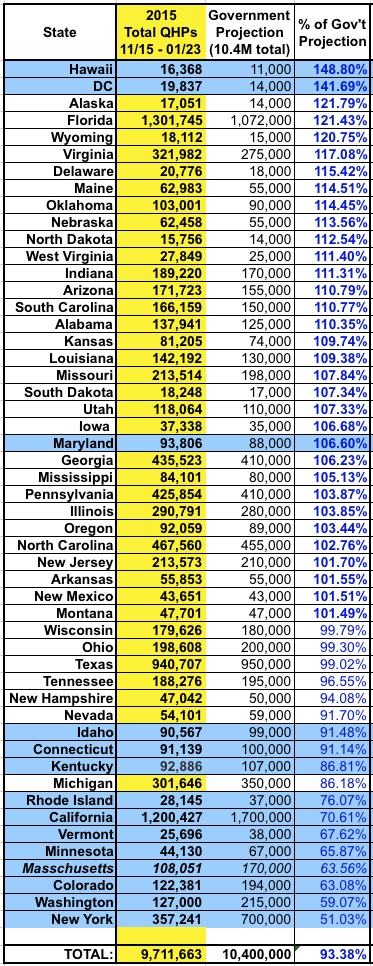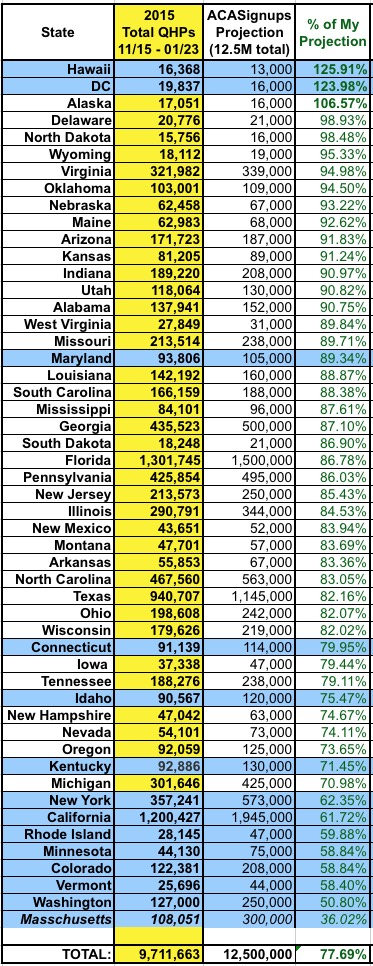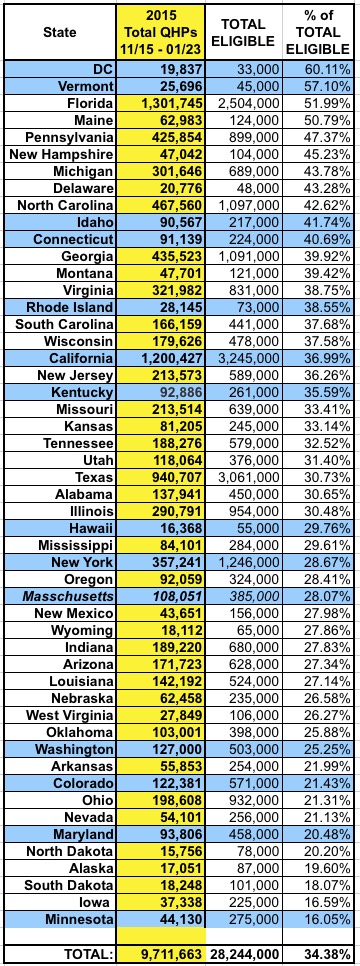Which states are doing the BEST this year?
There's several ways of measuring the performance of the states. You could go by sheer number of enrollees, but that's obviously unfair given the massive population differences between them. You can go by enrollments relative to their total population...except that some states have a much higher uninsured population than others, along with huge variations in average income, unemployment and a host of other variables.
In the end, I'm comparing the states across 4 different benchmarks:
- 1. How they're performing relative to last year's Open Enrollment Period
- 2. How they're performing relative to the "official" 2015 Open Enrollment Period targets put out by either the HHS Dept. (or the state government/exchange representative in some cases)
- 3. How they're performing relative to my 2015 Open Enrollment Period targets, and
- 4. How they're performing relative to the total potential exchange QHP enrollees.
Here's where things stand:
 Relative to 2014: Best-Performing States:
Relative to 2014: Best-Performing States:
- 1. Massachusetts (341%)
- 2. Hawaii (190%)
- 3. District of Columbia (185%)
- 4. Wyoming (151%)
- 5. Virginia (149%)
This one isn't even close, and with good reason. Massachusetts only enrolled about 32,000 people into private policies through their broken exchange last year, virtually none of whom actually qualified for tax credits (the system's inability to calculate the subsidy amount was one of the biggest problems with the old exchange). As a result, they had a couple hundred thousand people stuck in "healthcare limbo"...these people could afford to pay at least part of the QHP premiums, but there was no way of proving their eligibility for tax credits, so they were put into a "holding bin" of sorts for up to an entire year.
This year, the all-new system is working quite well, so those 200K people are being unleashed onto the new MA Health Connector, and their numbers are showing up in spades, with over 3.5x as many people now enrolled than during all of the 2014 Open Enrollment Period.
The next 3 states have such tiny populations to begin with that it doesn't take much to nearly double the numbers. As for Virginia...(shrug) beats me, but good for them.
UPDATE: From the comments:
you should also consider the geographical size. Wyoming is ranked number 10 (almost 98,000 square miles) with less than 50 assisters. Combine that with the difficulty of getting accurate information to citizens who often get their news from FOX or Republican leadership, Wyoming has done quite well so far.
 Relative to the Government Targets:
Relative to the Government Targets:
- 1. Hawaii (149%)
- 2. District of Columbia (142%)
- 3. Alaska (122%)
- 4. Florida (121%)
- 5. Wyoming (121%)
In 4 of the 5 cases, the reason is, again, obviously connected to the tiny population involved. Florida, however, is a huge outlier...but there's a reason for that as well.
In most cases, the "government target" is based on a simple 30% increase over 2014. The national HHS target is about 10.4 million, which is exactly 30% more than 8 million (the number as of April 2014), so in states which didn't have a specific target available (most of them), that's what I used.
In Florida, however, they did have an "official" target: 1,072,000 QHPs. In act, it was even more specific: 1,072,513, according to the Florida Office of Insurance Regulation. How they arrived at such a specific number I have no idea, but that's what they published last June, so there you have it. Since 1.072M would only be a 9% bump over 2014, it didnt' take much to surpass that goal.
 Relative to MY Targets: Best-Performing States:
Relative to MY Targets: Best-Performing States:
- 1. Hawaii (126%)
- 2. District of Columbia (124%)
- 3. Alaska (106%)
- 4. Delaware (99%)
- 5. North Dakota (98%)
My targets are all higher than HHS's (with the exception of New York); around 56% higher than 2014 in most cases. The top 3 are the same as the HHS targets for the same reason...tiny population to begin with. The 4th and 5th slots swap out 2 more small states (ND/DE) for Wyoming and...Florida.
The reason Florida isn't in the top 5 here is because I always felt that the 1.072M target was heavily lowballed to begin with.
Finally, we come to the long-term rankings: How many people has each state enrolled out of the total pool of potential enrollees? After all, only a certain portion of the population in each state is even eligible to enroll in a QHP via the ACA exchanges. This data comes straight from the Kaiser Family Foundation, which defines the total population eligible for ACA QHPs as:
...all individuals eligible for tax credits as well as other legally-residing individuals who are uninsured or purchase non-group coverage, have incomes above Medicaid/CHIP eligibility levels, and who do not have access to employer-sponsored coverage.
The estimate excludes uninsured individuals with incomes below the poverty level who live in states that elected not to expand the Medicaid program. These individuals are not eligible for financial assistance and are unlikely to have the resources to purchase coverage in the Marketplace.
KFF estimates that the total potential pool of exchange QHP enrollees--the maximum theoretical enrollment number--comes to around 28.2 million people nationally.
With that in mind...
 Relative to the Total Number of People Eligible: Best-Performing States:
Relative to the Total Number of People Eligible: Best-Performing States:
- 1. District of Columbia (60%)
- 2. Vermont (57%)
- 3. Florida (52%)
- 4. Maine (51%)
- 5. Pennsylvania (47%)
The first two on the list don't surprise me; again, DC and VT have small populations and are very liberal. While DC has a high percentage of low-income residents, they mostly qualify for Medicaid anyway. More significantly, both DC and VT have passed laws which effectively require everyone who purchases individual/family market insurance to do so via their exchanges: There are no "off-exchange" QHPs to be purchased. And Maine makes sense as well: Again, small popuation, etc.
However, Florida and Pennsylvania surprise me. I don't know enough about the demographics of either to comment, but it's a pleasant surprise to see 2 of the largest-population states ranking so well on this list.
I gave serious consideration to calling out the 5 worst-performing states in each category, but decided that would be unnecessarily cruel. Besides, some of the states had unrealistically high targets to begin with (especially New York).
How to support my healthcare wonkery:
1. Donate via ActBlue or PayPal
2. Subscribe via Substack.
3. Subscribe via Patreon.



